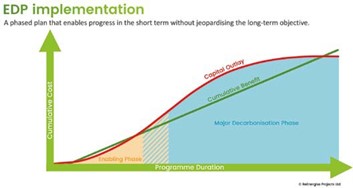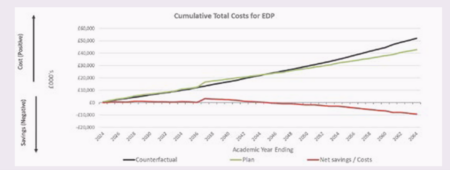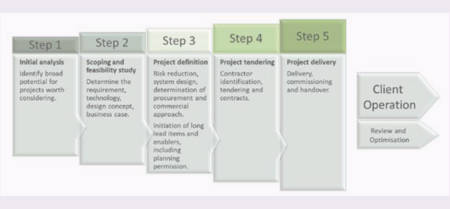Final plans for net-zero
Nigel Aylwin-Foster completes his series on how to achieve your school estate’s decarbonisation plan
In this series of articles, part one discussed definitions, the difference between net-zero carbon and net-zero energy, and what this all means for independent schools.
Part two discussed decarbonisation planning for schools in more detail, focusing on a type of plan that has come to be known as the estate decarbonisation plan, or EDP for short. (I can’t help but think of the Terminator films when I hear the term decarbonise: I know why we use it, but visions of Arnie Schwarzenegger arriving on set and declaring ‘this campus has been selected for decarbonisation’ keep springing to mind.
In this article I hope to bring the subject matter to life by looking at some EDP snapshots and consider what happens next, after the EDP, when Arnie has been and gone.
A brief recap
The purpose of the EDP is to determine a pragmatic, affordable programme of infrastructure projects that achieves the intended end-state – the net-zero school estate. The diagram below (featured in part 2) indicates what this programme might look like in theory:

Given that implementing the decarbonisation plan will entail significant capital outlay, at a time when funds are inevitably short, the trick will be to derive a programme of work that enables progress in the short term without jeopardising the long-term objective. Any short-term projects should be selected based on meeting two criteria: that they will be enablers for the longer-term projects and/or reduce operating costs. We can call this the enabling phase. It gives a school the opportunity to make a start on going green without needing to go into the red in the process. The major decarbonisation phase is when most of the expensive, disruptive projects will occur, the most significant being the conversion of the school’s provision of heating and hot water from fossil fuel systems to low-carbon alternatives.
There is deliberately no scale along the X or Y axes. The programme duration will depend on a range of factors, including when the existing heating plant reaches end-of-life, government-imposed deadlines for phasing out the purchase of new fossil fuel heating plant (currently 2035), and – not least – the school’s capacity to fund the work. The current trend in the independent sector is for a programme of about 20 years. The Y axis scale will, of course, depend on the size of the school estate: small independent schools might be facing a total capex in the order of £2-3 million to become net-zero carbon; for the largest schools in the UK it will be some £20-30 million, or even more if the school also wants to become as energy self-sufficient as commercial good sense and the school’s real estate allows. In short, becoming net-zero is rather a big deal, and it merits a comprehensive plan.
Inside a school EDP
Next, some examples of what this looks like in practice, using extracts from an authentic school EDP.
The chart below shows an extract from an EDP for a large day school in an urban setting, covering the enabling plan’s major projects (building names have been sanitised):

The school will be engaging in a range of energy efficiency and on-site power generation projects (all identified and examined in detail in the plan). The net financial impact of these projects will be as shown on the chart below:

In other words, once all these projects have collectively paid back (after a total of six years) the school will be making significant financial gains in operating costs. It all seems like a no-brainer, but it does matter that the various measures have been realistically costed and modelled and that the cash flow doesn’t exceed the annual limits set by the school; this is no place for wishful thinking.
The related main decarbonisation phase is shown in the chart below. Note that the school is not rushing into this work – there’s no need to do so from a compliance and regulatory perspective, while from the school’s commercial and cash flow perspective it makes sense to spread the projects over several years:

The general strategy in this plan is to match the phasing out of the incumbent fossil fuel heating plant with the principles and deadlines enshrined in UK government policy, combined with pragmatic use of the projected end-of-life of the outgoing plant. Likewise, electric vehicle (EV) charging points are to be installed in two tranches, to match the period when the school’s transport fleet is likely to be converted (in turn driven by when the EV market will achieve commercial parity with the internal combustion engine market). This all leads to a steady rate of change, rather than a blitz of projects over a short period, which in turn enables the school to get to a net-zero carbon estate within the cash flow constraints imposed year on year – in other words, to go green without going into the red.
The overall plan finances are shown in the next two charts. The first chart shows how the net effect of the plan is to reduce operating costs steadily over the life of the plan:

But, of course, this can only be achieved via capital investments and the key requirement from the school’s perspective is to ensure that capex in any given year remains within the intended limits. The next chart shows cumulative costs versus the counterfactual of doing the minimum to remain compliant with forthcoming legislation:

Carbon emissions
So far we have not discussed the impact on carbon emissions. We should, but I’ve done it in this order quite deliberately, because the money must come first – we are, after all, trying to go green without going into the red.
The chart below shows the pathway to net-zero for the same EDP, compared to the counterfactual of maintaining the status quo and only taking any proactive steps to get rid of fossil fuel systems at the last safe moment. The implications are self-explanatory.

UK government policy
So, what of the legislation? There have been some recent changes, but the latest key policy nuggets are shown in the diagram below.

The statements in red font merit elaboration. The government is trying to match the need for steady progress with a matching need not to incur undue waste by getting rid of perfectly good fossil fuel heating plant ahead of its end of life. The principle is that no heating plant should be removed before end of life (unless there’s some other good reason) but that from 2035, when fossil fuel plant reaches end of life or becomes due replacement, then that replacement must be a low-carbon alternative. Also note the statement in green font; the intent is that grid electricity and gas prices will gradually shift in balance over the next few years, such that heat pumps become commercially more attractive than gas boilers.
While here, also note the statement about the national power grid – it has a government target to decarbonise. The implication is that schools don’t need to install lots of on-site power generation (and storage where relevant) in order to get estate power to net-zero – the grid will do that for schools. However, as we’ve seen in the enabling plan extract above, there are sound financial reasons to embark on a programme of projects that will reduce the school’s reliance on grid power as far as reasonably possible, In other words, this is a financial play, not a net-zero carbon one.
Summary
It should be obvious by now that achieving net-zero is a challenging endeavour. The key will be to determine the right pace. It needs to be consistent with both regulatory requirements and the annual cash flow constraints at the school. I believe that with sound and careful planning that balance should be achievable for independent schools in the UK, without needing to hear the dreaded T-word from Arnie.
But what’s next?
The EDP is part of a broader step-by-step risk-reduction process required for decarbonising a school estate. Engineering and commercial logic suggests five steps, as shown below:

Readers may recognise a process similar in concept to the Royal Institute of British Architects process. It works well for individual projects or a grouping of projects (a programme). It is designed to flush out potential costly mistakes and dead ends, which can then be avoided. The idea is that each step is progressively more substantial, with the major expenditure not until Step 5. A school only commits to the next step in the process once the preceding step has justified continued progression. Conversely, if a major hurdle is encountered that undermines the prospect of successful completion, then the process can be halted. For example, during Step 3 – project definition – it may become clear that in order to convert the heating to heat pumps the school estate will need an upgrade in power from the grid and that upgrade will be prohibitively expensive. Or, more likely, the upgrade cannot be done until a specific year in the future and therefore the heat pump project will have to be delayed accordingly.
The EDP serves as Step 2 in this process. It would be expected to follow on from a period of initial broad analysis and discussions between the supporting consultants and relevant school staff, under Step 1. The output from the EDP is the draft programme for the decarbonisation of the school estate across the entirety of the school’s heat, transport and power inventory, plus all the supporting detail to justify the programme. As we’ve seen, the draft programme contains a range of projects. The EDP should indicate the linkage between them, but each project will merit its own Step 3, 4 and 5. The diagram below illustrates how this might work:

In this example – from a different school’s EDP – the energy efficiency works, solar photovoltaics (PV) projects, EV charging point installations, and CHP (combined heat and power) project are all part of the enabling phase. They all reduce operating costs and save money relatively quickly, so there’s no reason to delay them – always provided that the annual capex can be kept within the school’s limits. The later projects are mainly concerned with heating plant replacement, as in the previous case study.
Nigel Aylwin-Foster is the business development director for school estate decarbonisation firm ReEnergise Projects.

Nigel Aylwin-Foster
